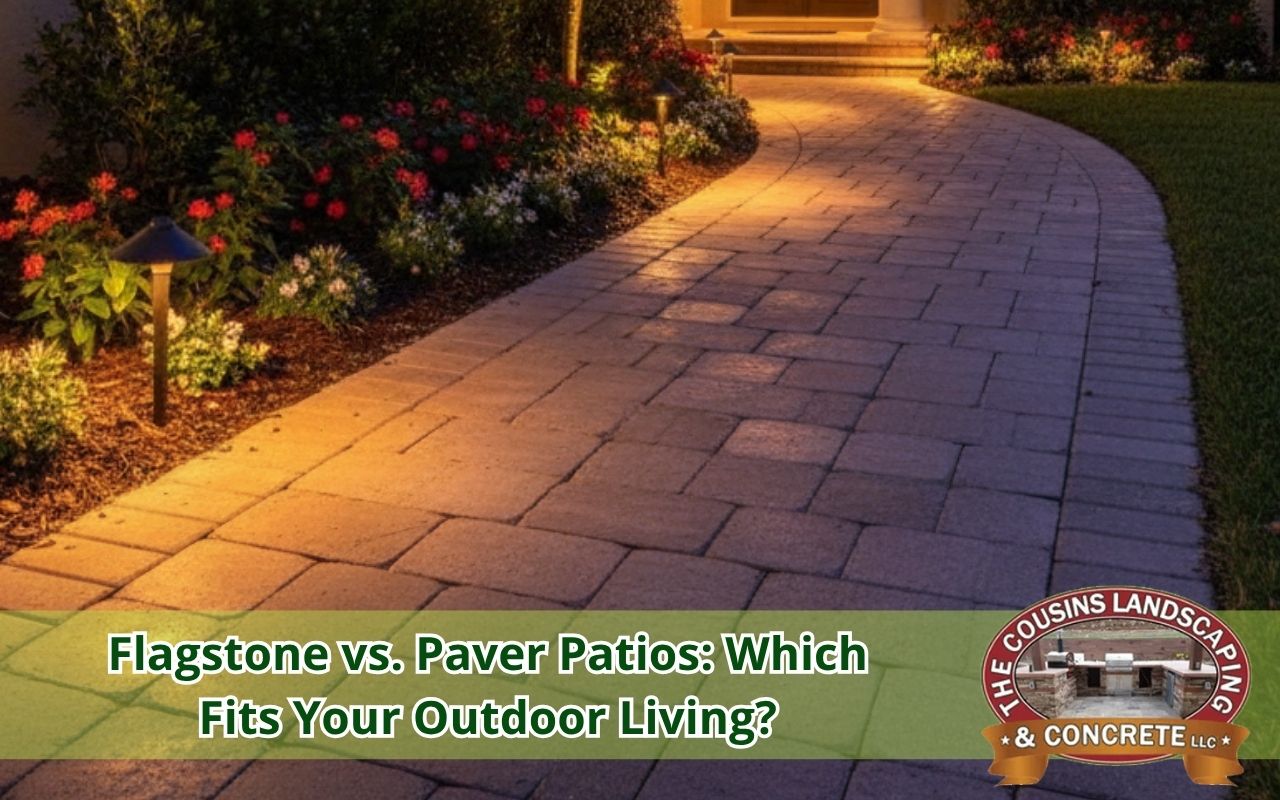
Designing your dream backyard involves choosing the right foundation. The debate over flagstone patio vs paver patio continues to inspire homeowners. Both materials elevate outdoor living, yet each brings unique charm and practical benefits. Choosing between them depends on durability, appearance, installation, and maintenance needs.
Flagstone offers a rugged, natural look that blends beautifully with gardens and stone walls. Meanwhile, pavers provide clean lines and endless design options. As you plan your outdoor upgrade, understanding both options will help create a functional and elegant patio. With thoughtful preparation and expert installation, either can transform your space into a stunning retreat.
Durability Comparison: Understanding the Longevity of Flagstone and Paver Patios
When comparing flagstone patio vs paver patio, durability often determines the winner. Flagstone naturally resists heavy wear and lasts for decades with proper installation. However, it requires careful base preparation to prevent shifting and cracking. A solid gravel and sand foundation ensures stability during freeze-thaw cycles.
In contrast, paver patios feature uniform strength. Each concrete or brick paver is engineered for endurance, resisting cracks under normal loads. Moreover, individual pavers can be replaced if one becomes damaged, simplifying repairs. Proper drainage design also helps prevent erosion, which keeps your patio stable and strong through Colorado’s seasons.
- Compact the base thoroughly before laying stones or pavers.
- Seal flagstone to reduce water infiltration and frost damage.
- Use polymeric sand in paver joints for stability and drainage.
Aesthetics Showdown: Exploring the Visual Appeal
Flagstone patios bring natural elegance. Their irregular shapes and earthy tones blend harmoniously with landscapes. The organic patterns create a relaxed, timeless atmosphere ideal for rustic or garden-inspired designs. Additionally, the variety of textures enhances depth and shadow, making each installation unique.
Paver patios deliver symmetry and precision. Their consistent shapes allow for creative layouts like herringbone or basket weave. This versatility lets you align your patio design with your home’s architecture. Bright colors and defined borders make pavers perfect for modern outdoor spaces that emphasize clean structure.
- Flagstone complements natural surroundings and curved pathways.
- Pavers offer consistent color and pattern options.
- Both materials boost property appeal and style.
Installation Process: Contrasting the Methods for Laying Patios
Installing a flagstone patio demands artistry and patience. Each stone must fit together like a puzzle. Because flagstone varies in thickness and shape, leveling the surface requires precision. Use a rubber mallet to position each slab securely into place, ensuring even spacing and solid footing.
Paver patios, on the other hand, follow a standardized sequence. Once the base is compacted, edge restraints hold the pattern. The uniform size of pavers simplifies layout and speeds up installation. As a result, many homeowners find pavers easier to install or repair over time.
Maintenance Requirements: Keeping Your Patio in Top Condition
Maintenance is another deciding factor in the flagstone patio vs paver patio discussion. Flagstone requires periodic sealing to prevent stains and weather damage. Regular sweeping and gentle washing help maintain its natural look. However, uneven slabs may need occasional repositioning if frost causes shifting.
Paver patios typically require less upkeep. Sweeping and reapplying polymeric sand every few years keeps joints tight. Sealing pavers enhances their color and reduces oil or dirt buildup. Because individual pavers are replaceable, long-term care is straightforward and cost-effective.
Cost Analysis: Comparing Budget Factors
Evaluating costs for flagstone patio vs paver patio involves both materials and labor. Flagstone’s irregular shapes make installation labor-intensive, increasing total expenses. Nevertheless, its timeless beauty and longevity can justify the investment. For homeowners seeking natural luxury, flagstone offers lasting value.
Pavers generally cost less to install and repair. The uniform blocks reduce labor hours, and DIY projects are often possible. Still, premium pavers can rival flagstone prices, especially when incorporating intricate patterns. Balancing aesthetics, budget, and installation time ensures a smart investment in your outdoor retreat.
Climate Considerations: How Weather Affects Each Material
Colorado’s climate demands strong materials. Freeze-thaw cycles can stress both flagstone and paver patios. Flagstone may absorb water that expands as it freezes, leading to cracks if not properly sealed. Choosing denser stones and ensuring good drainage helps maintain integrity.
Pavers generally handle moisture better thanks to tight joints and a flexible sub-base. They allow natural movement without major damage. Moreover, lighter-colored pavers reflect heat, keeping surfaces cooler in summer. Whether in snow or sunshine, proper installation ensures year-round performance for both options.
Customization Options: Exploring Flexibility in Design
Flagstone patios showcase individuality. Each piece of stone contributes to a unique mosaic, creating a one-of-a-kind pattern. Installers can shape stones to fit curves, integrate accent borders, or frame fire pits. The result feels organic and tailored to the landscape.
Pavers excel in modular design flexibility. Mix colors, sizes, and textures for creative layouts. You can even add decorative inlays or edge patterns. This customization makes pavers ideal for homeowners who enjoy evolving their outdoor design with ease.
- Flagstone suits freeform layouts and natural designs.
- Pavers support geometric and modern aesthetics.
- Both materials adapt to outdoor kitchens, walkways, and terraces.
FAQs
What are the main differences between flagstone and paver patios?
Flagstone offers natural irregular beauty, while pavers deliver precision and uniformity. Both can be durable with proper base preparation.
Which lasts longer, flagstone or pavers?
Both last decades when installed correctly. However, flagstone may require more maintenance to prevent cracking over time.
Can pavers look as natural as flagstone?
Yes, textured pavers can mimic natural stone, but flagstone’s organic shape and color variation remain unmatched for authenticity.
Are flagstone patios harder to install?
Yes, their irregular shapes make installation more labor-intensive. However, skilled installers can achieve a stunning, lasting finish.
Where can I find professional help for patio installation?
For expert guidance and installation, visit our Our Services page. You can also Contact Us for personalized support.
Decision Time: Making the Right Choice for Your Outdoor Space
When it comes to flagstone patio vs paver patio, your ideal choice depends on design goals, maintenance preferences, and budget. Flagstone radiates timeless beauty and blends naturally with landscapes. Pavers, meanwhile, offer versatility, lower maintenance, and customizable style.
Whether you favor the rugged charm of natural stone or the sleek precision of pavers, both can elevate your outdoor experience. Explore your options and create a space that fits your vision perfectly. For expert assistance, check out Our Services and start building your ideal patio today.
